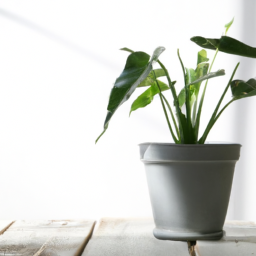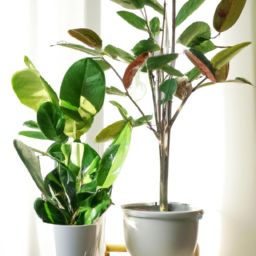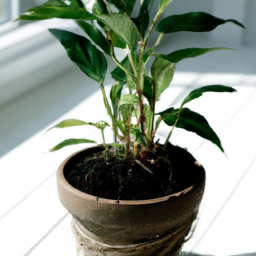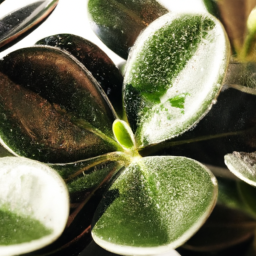
Hey there! Have you ever wondered if indoor plants can actually purify the air in your home? Well, you’re in the right place because today we’re going to dive into the fascinating world of indoor plants and their potential air-purifying abilities. Many people believe that having a few green companions around can improve the air quality, but is it just a myth or is there some truth to it? In this blog post, we’ll explore the science behind this popular claim, debunk any misconceptions, and uncover whether indoor plants really have the power to purify the air. So, let’s get started and find out if those leafy houseplants are more than just beautiful decorations!
The Science Behind Indoor Plants’ Air Purification Abilities
Indoor plants have long been praised for their ability to enhance the aesthetic appeal of our homes and offices. However, recent studies have shown that these green companions offer more than just visual pleasure. They have the remarkable ability to purify the air we breathe, making our indoor environments healthier and more pleasant to live in. In this article, we will delve into the science behind indoor plants’ air purification abilities and discover how they can improve the quality of the air we breathe.
Understanding Indoor Air Pollution
Before we dive into the specifics of how indoor plants purify the air, let’s first understand the problem they are addressing: indoor air pollution. Indoor air pollution refers to the presence of harmful pollutants in the air inside buildings, which can have adverse effects on our health. These pollutants can come from various sources such as building materials, cleaning products, and even outdoor air that infiltrates indoors.
Common indoor air pollutants include volatile organic compounds (VOCs), formaldehyde, benzene, and carbon monoxide. These pollutants can cause a range of health issues, including respiratory problems, headaches, allergies, and even more severe conditions in the long term.
Now that we have a clear understanding of the problem, let’s explore how indoor plants can help combat indoor air pollution.
The Air Purification Mechanism of Indoor Plants
Plants have a fascinating ability to remove harmful pollutants from the air through a process called phytoremediation. Phytoremediation is the use of plants to clean up, detoxify, and stabilize pollutants in the environment. When it comes to indoor plants, they primarily rely on their leaves, roots, and the microorganisms living in the soil to purify the air.
Leaves play a crucial role in air purification as they absorb gases and microscopic particles through tiny openings called stomata. Once inside the plant, these pollutants are broken down and transformed into harmless substances through various biochemical processes. Some pollutants are used as nutrients by the plant, while others are released back into the air in a less harmful form.
Roots are equally important in the air purification process. They act as filters, trapping airborne pollutants and preventing them from circulating in the indoor environment. Additionally, the microorganisms present in the soil around the roots help break down and neutralize certain pollutants, further enhancing the air purification capabilities of indoor plants.
It’s important to note that different plants have varying degrees of air purification abilities. Some plants are more efficient at removing specific pollutants, while others excel at overall air purification. Therefore, it’s advisable to have a variety of plants to maximize the benefits.
Choosing the Right Plants for Air Purification
Now that we understand how indoor plants purify the air, let’s explore some of the best plant options for improving indoor air quality:
1. Spider Plant (Chlorophytum comosum): Spider plants are known for their ability to remove formaldehyde, xylene, and toluene from the air. They are easy to care for and can thrive in a variety of indoor conditions.
2. Peace Lily (Spathiphyllum): Peace lilies are excellent at removing common indoor air pollutants such as benzene, trichloroethylene, and ammonia. They also add a touch of elegance with their beautiful white flowers.
3. Snake Plant (Sansevieria trifasciata): Snake plants are highly effective at removing formaldehyde, nitrogen oxide, and benzene. They are also known for their ability to release oxygen at night, making them ideal for bedrooms.
4. Areca Palm (Dypsis lutescens): Areca palms are great at removing formaldehyde, xylene, and toluene. They are also excellent humidifiers, adding moisture to dry indoor environments.
5. Boston Fern (Nephrolepis exaltata): Boston ferns are natural air humidifiers and can effectively remove formaldehyde, xylene, and toluene. They require a bit more care, including regular misting and indirect sunlight.
Remember to choose plants that suit your indoor environment and personal preferences. Providing proper care, including adequate light, water, and occasional fertilization, is essential for their optimal air purification performance.
In conclusion, indoor plants have a remarkable ability to purify the air we breathe by removing harmful pollutants. Through phytoremediation, plants absorb and transform these pollutants, making our indoor environments healthier and more enjoyable. By choosing the right plants and providing them with the care they need, we can harness their air purification abilities and create a cleaner and fresher indoor atmosphere.

Can Indoor Plants Really Purify the Air?
When it comes to improving indoor air quality, many people turn to indoor plants as a natural and aesthetically pleasing solution. But do these plants actually have the ability to purify the air we breathe? Let’s delve into the science behind indoor plants and their air-purifying capabilities.
Understanding Indoor Air Pollution
Before we dive into the world of indoor plants, it’s important to understand the concept of indoor air pollution. Indoor air can be contaminated with various pollutants such as volatile organic compounds (VOCs), formaldehyde, benzene, and other harmful chemicals. These pollutants can be emitted from building materials, furniture, cleaning products, and even the air fresheners we use.
Indoor air pollution can lead to a range of health issues, including respiratory problems, allergies, and even long-term conditions like asthma. This is where indoor plants come into play.
The Science Behind Indoor Plants and Air Purification
Plants have the remarkable ability to absorb gases through tiny pores in their leaves, called stomata. They take in carbon dioxide for photosynthesis and release oxygen as a byproduct. But certain plants can also absorb harmful chemicals present in the air, effectively purifying it.
Research conducted by NASA in the late 1980s found that certain indoor plants can indeed remove common pollutants from the air. These plants act as natural air filters, trapping toxins on their leaves and roots, and converting them into harmless substances. This process is known as phytoremediation.
It’s important to note that while indoor plants can help improve air quality, they are not a complete solution for eliminating all indoor pollutants. They work best when combined with proper ventilation, regular cleaning, and minimizing the use of chemical-laden products.
Top Indoor Plants for Air Purification and Their Benefits
Now that we understand the science behind indoor plants and air purification, let’s explore some of the top plants known for their air-purifying properties:
1. Snake Plant (Sansevieria trifasciata)
The Snake Plant is a popular choice for indoor spaces due to its ability to thrive in low-light conditions. It is known for its ability to remove toxins such as formaldehyde, benzene, xylene, and trichloroethylene from the air. Additionally, this plant releases oxygen at night, making it an ideal choice for bedrooms.
Snake Plants are relatively low-maintenance and can survive with minimal watering, making them perfect for busy individuals or those new to plant care.
2. Peace Lily (Spathiphyllum)
The Peace Lily is not only a visually appealing plant but also an excellent air purifier. It effectively removes common indoor pollutants like formaldehyde, benzene, and trichloroethylene. This plant also increases humidity levels, which can be beneficial in dry indoor environments.
Peace Lilies thrive in indirect light and prefer slightly moist soil. However, it’s important to note that the leaves of this plant can be toxic to pets if ingested, so keep it out of reach of furry friends.
3. Spider Plant (Chlorophytum comosum)
The Spider Plant is a resilient and easy-to-grow plant that is known for its air-purifying abilities. It effectively removes formaldehyde, xylene, and carbon monoxide from the air. This plant also produces oxygen while purifying the air, creating a healthier indoor environment.
Spider Plants thrive in bright, indirect light and require well-draining soil. They are also known for their ability to produce “spiderettes,” small plantlets that can be propagated and shared with friends and family.
While these are just a few examples, there are many other indoor plants that can help improve air quality. It’s important to choose plants based on your specific needs, such as lighting conditions and personal preferences.
Conclusion
Indoor plants can indeed play a role in purifying the air we breathe. Their ability to absorb and convert harmful pollutants into harmless substances makes them a valuable addition to any indoor space. However, it’s essential to remember that indoor plants are not a standalone solution for air purification. They should be used in conjunction with proper ventilation, regular cleaning, and minimizing the use of chemical products for optimal results.
So, why not bring some greenery into your home or office? Not only will indoor plants enhance the aesthetic appeal of your space, but they will also contribute to a healthier and cleaner indoor environment.

Debunking Myths: Do Indoor Plants Actually Improve Air Quality?
When it comes to improving the air quality in our homes or offices, indoor plants have been touted as a natural and effective solution. But do they really live up to the hype? In this article, we will delve into the scientific evidence behind the claims and provide you with a step-by-step guide to understanding whether indoor plants can truly purify the air.
Understanding Indoor Air Quality
Before we dive into the world of indoor plants, it’s important to grasp the concept of indoor air quality. The air we breathe indoors can be filled with various pollutants such as dust, mold spores, volatile organic compounds (VOCs), and even harmful gases like carbon monoxide. These pollutants can have adverse effects on our health, leading to respiratory issues, allergies, and other related problems.
Improving indoor air quality is crucial for maintaining a healthy living or working environment. While there are several methods to achieve this, indoor plants have gained popularity due to their natural ability to filter and purify the air.
The Science Behind Indoor Plants’ Air Purification
Indoor plants have been found to possess air-purifying qualities through a process known as phytoremediation. This process involves the plants absorbing pollutants from the air through their leaves and roots, metabolizing or neutralizing them, and releasing cleaner oxygen back into the environment. It’s a fascinating natural mechanism that has been studied extensively by scientists.
Research has shown that certain indoor plants have the ability to remove common indoor pollutants such as formaldehyde, benzene, and trichloroethylene. These chemicals are often found in household items like furniture, carpets, and cleaning products. By having these plants in our living or working spaces, we can potentially reduce the levels of these harmful substances.
However, it’s important to note that the effectiveness of indoor plants in purifying the air depends on various factors such as the type of plant, the size of the space, and the level of pollutants present. Let’s explore these factors in more detail.
Choosing the Right Indoor Plants
Not all indoor plants are created equal when it comes to air purification. Some plants are more efficient at removing specific pollutants, while others may not have a significant impact. Here are a few popular indoor plants known for their air-purifying qualities:
1. Snake Plant (Sansevieria trifasciata): This plant is known for its ability to filter out formaldehyde, a common indoor pollutant. It’s also low-maintenance and can thrive in low light conditions.
2. Spider Plant (Chlorophytum comosum): Spider plants are excellent at removing formaldehyde and carbon monoxide from the air. They are easy to care for and can be a great addition to any indoor space.
3. Peace Lily (Spathiphyllum wallisii): Peace lilies are known for their ability to remove multiple pollutants, including benzene and trichloroethylene. They also add a touch of elegance to any room with their beautiful white flowers.
These are just a few examples, and there are many other plants that can contribute to improving indoor air quality. When selecting indoor plants, consider factors such as their air-purifying capabilities, maintenance requirements, and suitability for the specific environment.
Optimizing Air Purification with Indoor Plants
While indoor plants can help improve air quality, they are not a standalone solution. To maximize their effectiveness, it’s important to follow these steps:
1. Increase plant density: The more plants you have, the better the air purification. Consider placing multiple plants in different areas of your space to create a healthier environment.
2. Choose the right-sized plants: Larger plants have a greater capacity to purify the air. Opt for plants with a substantial leaf surface area to maximize their air-filtering potential.
3. Provide adequate light: Most indoor plants require sufficient light to thrive. Ensure they are placed in areas where they can receive the right amount of sunlight or artificial light.
4. Maintain proper care: Regularly water and clean your indoor plants to keep them healthy. Dust the leaves to prevent the buildup of pollutants and ensure optimal air purification.
By following these steps, you can create an environment that maximizes the air-purifying benefits of indoor plants.
Conclusion
So, do indoor plants actually improve air quality? The answer is yes, but with some caveats. While indoor plants have been scientifically proven to filter and purify the air, their effectiveness depends on various factors. Choosing the right plants, optimizing their placement, and providing proper care are all crucial for achieving the desired results.
When it comes to improving indoor air quality, indoor plants should be seen as a complementary solution rather than a sole remedy. Incorporating them into your living or working spaces can contribute to cleaner and healthier air, but it’s important to combine them with other air quality improvement methods for optimal results.
So, why not bring some greenery into your indoor spaces and enjoy the potential benefits of air-purifying plants? Not only will they add beauty and tranquility, but they may also help create a healthier environment for you and your loved ones.
Key Takeaways
Indoor plants have become increasingly popular in recent years, not only for their aesthetic appeal but also for their alleged ability to purify the air. But can these leafy companions really make a difference in the air quality of our homes? Let’s dive into the science behind it.
Numerous studies have shown that certain indoor plants can indeed help remove harmful toxins from the air. Through a process called phytoremediation, plants absorb pollutants such as formaldehyde, benzene, and trichloroethylene, which are commonly found in household products and materials. These chemicals can have detrimental effects on our health, causing respiratory issues and even increasing the risk of certain diseases. However, it’s important to note that while plants can effectively remove these toxins, they do so at a relatively slow rate. To significantly improve indoor air quality, a large number of plants would be required, far more than what is typically found in an average household.
FAQ Roundup:
Q1: Can indoor plants really purify the air?
A1: Absolutely! Indoor plants have the remarkable ability to purify the air by removing harmful toxins and releasing oxygen. Numerous scientific studies have shown that certain plants can effectively filter out pollutants, such as formaldehyde, benzene, and trichloroethylene, which are commonly found in indoor environments.
Q2: How do indoor plants purify the air?
A2: Indoor plants purify the air through a process called phytoremediation. They absorb pollutants through their leaves and roots, and then convert them into harmless substances or store them within their tissues. Additionally, plants release moisture into the air through a process called transpiration, which can help improve humidity levels and reduce airborne particles.
Q3: Which indoor plants are best for air purification?
A3: Several indoor plants are known for their exceptional air-purifying qualities. Some popular choices include the Spider Plant, Peace Lily, Snake Plant, Boston Fern, and Aloe Vera. These plants are not only visually appealing but also highly effective in removing toxins from the air, making them excellent choices for improving indoor air quality.
Q4: How many indoor plants do I need to purify the air in my home?
A4: The number of indoor plants needed to purify the air in your home depends on various factors, such as the size of your space, the number of rooms, and the level of air pollution. As a general guideline, it is recommended to have at least one medium-sized plant (6-8 inch pot) per 100 square feet of living space. However, having more plants can enhance the air-purifying effect.
Q5: Can indoor plants have any negative effects on air quality?
A5: While indoor plants are generally beneficial for air quality, it’s important to note that overwatering or poorly maintained plants can potentially lead to mold growth, which can negatively impact air quality. To prevent this, ensure proper drainage, avoid overwatering, and provide adequate ventilation. Additionally, some individuals may have allergies or sensitivities to certain plants, so it’s advisable to choose plants that are well-tolerated by everyone in the household.
Dr. Olivia Green is a botanist with over two decades of experience in indoor plant cultivation. She holds a Ph.D. in Plant Biology and has dedicated her career to researching plant behavior in controlled environments. Dr. Green is passionate about helping plant enthusiasts master the art of indoor gardening through her extensive knowledge and practical insights.


